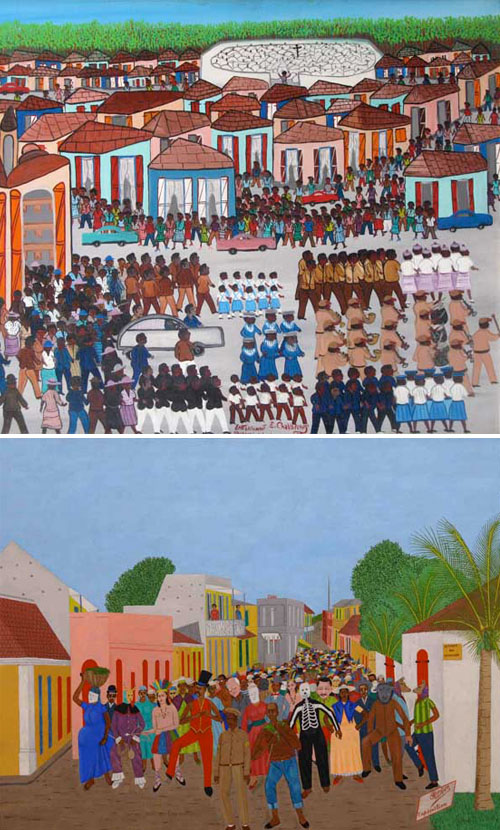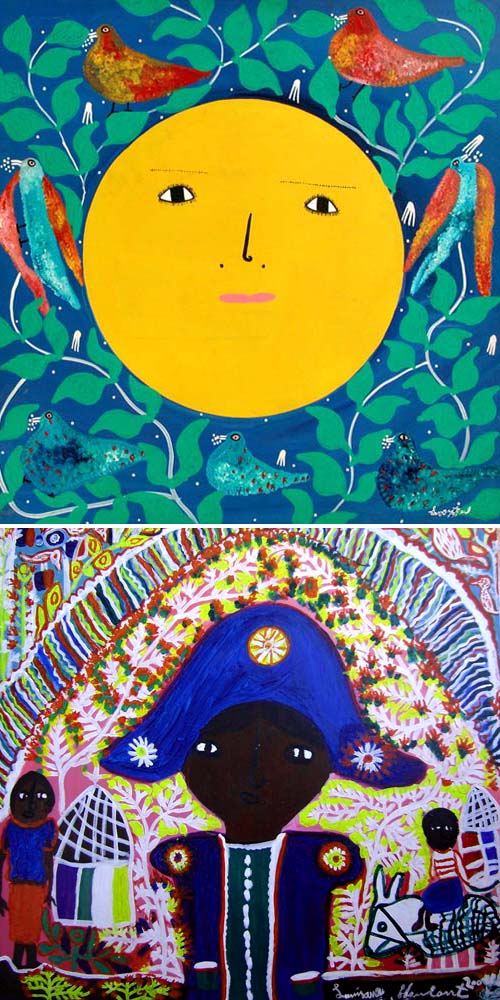Deeps > Representing Bois Caïman > Painting Mystery and Memory: Bois Caïman in Visual Art > Haitian Painting
The artists discussed on the Painting Mystery and Memory: Bois Caïman in Visual Art page are just a handful of the many talented Haitian artists. Many more paint scenes of countryside, or moments of the revolution, still life, other representations of Bois Caïman, and (perhaps especially) vodou. This movement that produced so much talent traces its beginnings back to the 1940’s when an American, DeWitt Peters, sponsored by the US Department of Education, moved to Haiti to teach English. He made the move in 1943 and a year later opened Le Centre d’Art in Port-au-Prince as a teaching center and gallery.[i] It became, however, much more than that. Painters like Pilomé Obin, Benoit, Bazile, Cayemitte began sending their work to the center[ii] and it turned from a simple gallery and teaching center into a catalyst for artistic talent (some might say genius) and a new player in the international art scene. As Carol Damian says, “Haiti’s art reflects a cultural and national identity that manifests itself in an extraordinary outpouring of visual imagery. The art of Haiti, especially painting, has long been recognized by an international community for its innate genius, enchanting beauty, and rich mythical content.”[iii] Below are examples of work from famous Haitian artists Etienne Chavannes (top) and Philome Obin (bottom).
Recognizable themes reoccur in Haitian painting. Themes like country and everyday life, market women, landscapes, and vodou. In Damian’s words, Haitian artists capture the history, rituals, beauty, and daily activities of the country and its people.”[iv] Additionally, Candace Russel discusses these themes saying, “Common painting styles and focus areas [include]: Fantasy Landscapes, Voudun, Cap-Haitien, [and] Saint Soleil…[Cap-Haitien] is a style of painting, focusing on daily life and historical subjects…” Artists of the Cap-Haitian style include: Philomé Obin, Seneque Obin, Jean Baptiste Jean, Jonas Profil, and Étienne Chavannes (see above for examples). Saint Soleil style is a style with “dramatic color juxtapositions, reverence for nature and Vodou, and the ability to express the mystery of creation.” Artists include Levoy Exil, Louisiane Saint Fleurant, Dieuseul Paul, and Denis Smith, Antoine Smith, Saint Jacques Smith, and Lesly Richard.[v] Examples of Exil’s work (top) and Saint Fleurant’s work (bottom) are shown below.
Many of the painters noted above execute their work within the context of the naïve tradition. Apraxine describes this movement:
The body of art known as “Haitian Naïve Painting” is a tangible result of this transition from the invisible state of folkways and symbols to the formal visions of individual painters. To describe such art as “naïve,” however, inadequately expresses its essence…In the Western sense naïve art is a personal, individual adventure, often undertaken in reaction to the anonymity and isolation of a highly advanced technological state of human existence…it is in reaction to an extremely individualized state of society and fragmented consciousness. In many respects it is a vision of lost origins, reflecting images of the collective race or the style of a bygone folk culture. In contrast, those painters who gathered around Le Centre d’Art in Haiti were not reacting against an “advanced” state of existence by drawing closer to the source of collective identity, or remembering a lost popular vision. They were moving away from the undifferentiated consciousness of the collective life towards the individuality of paintings by which they were identified. What a Douanier Rousseau and Obin share as “naïve” painters is their totally individual styles, while siphoning their images from the collective consciousness and their inspiration from the real of imagine life of the people.”[vi]
Painting and Revolution
Be sure to visit the other pages in the Bois Caïman section: Religion, Music, Geneology of sources.
Want to cite this page? Just copy and paste! Here ya go: Young, Courtney. “Haitian Painting, A Little Context.” The Black Atlantic. Duke University.
Painting sources:
Chavannes (top) / Obin (bottom)
Exil (top)/ Saint Fleurant (bottom)


nice work,I had never seen paintings from Haiti before, I enjoy the colors very much !